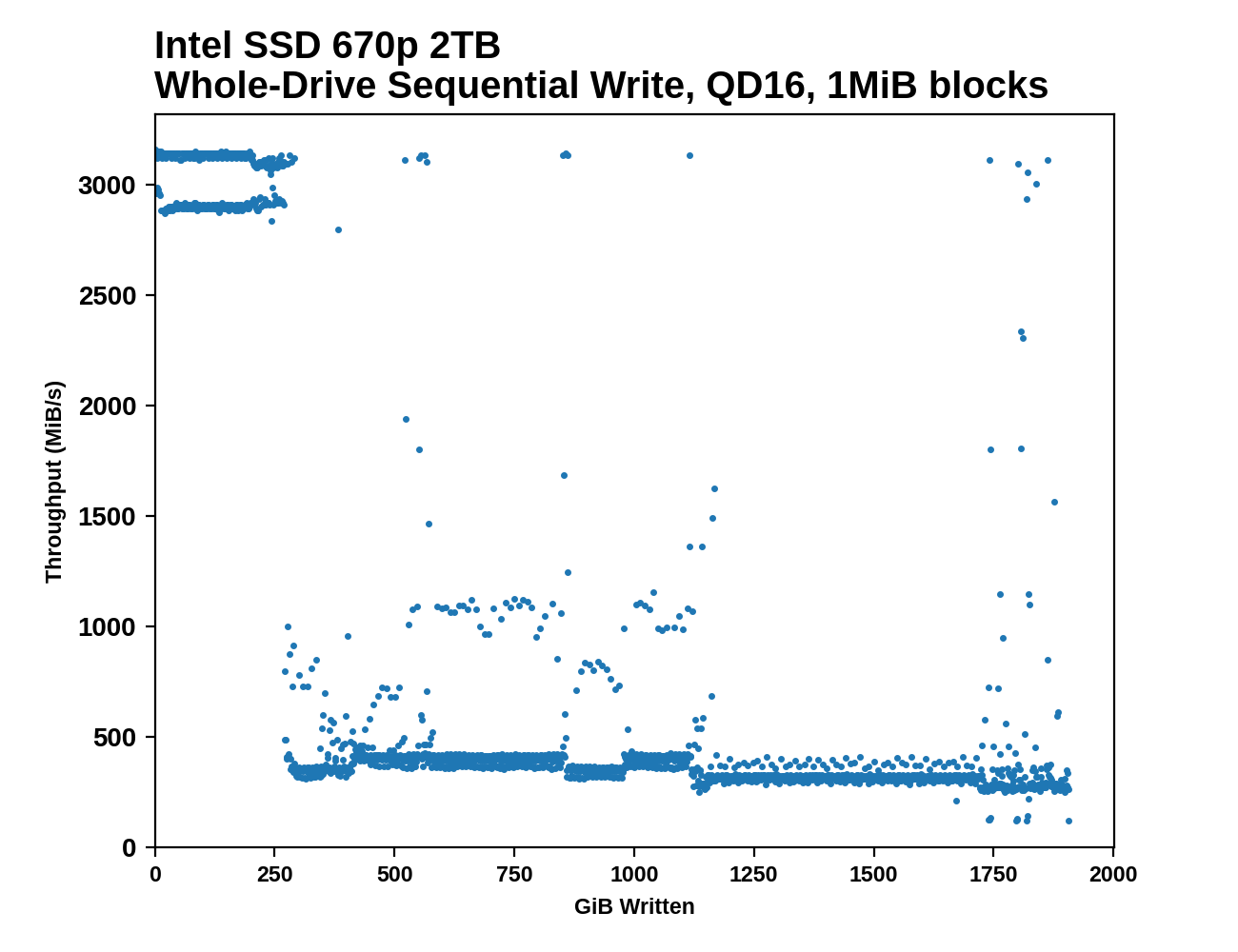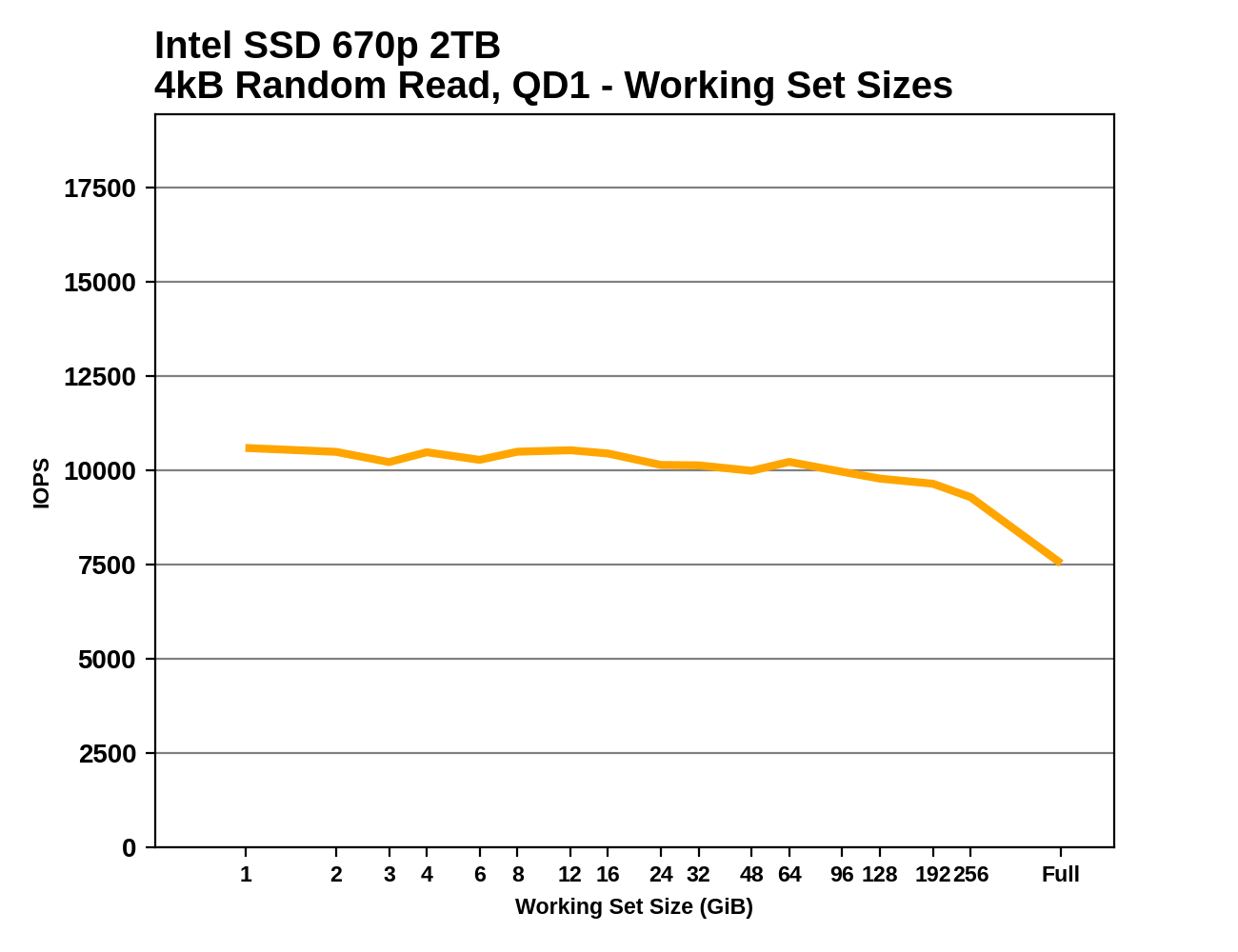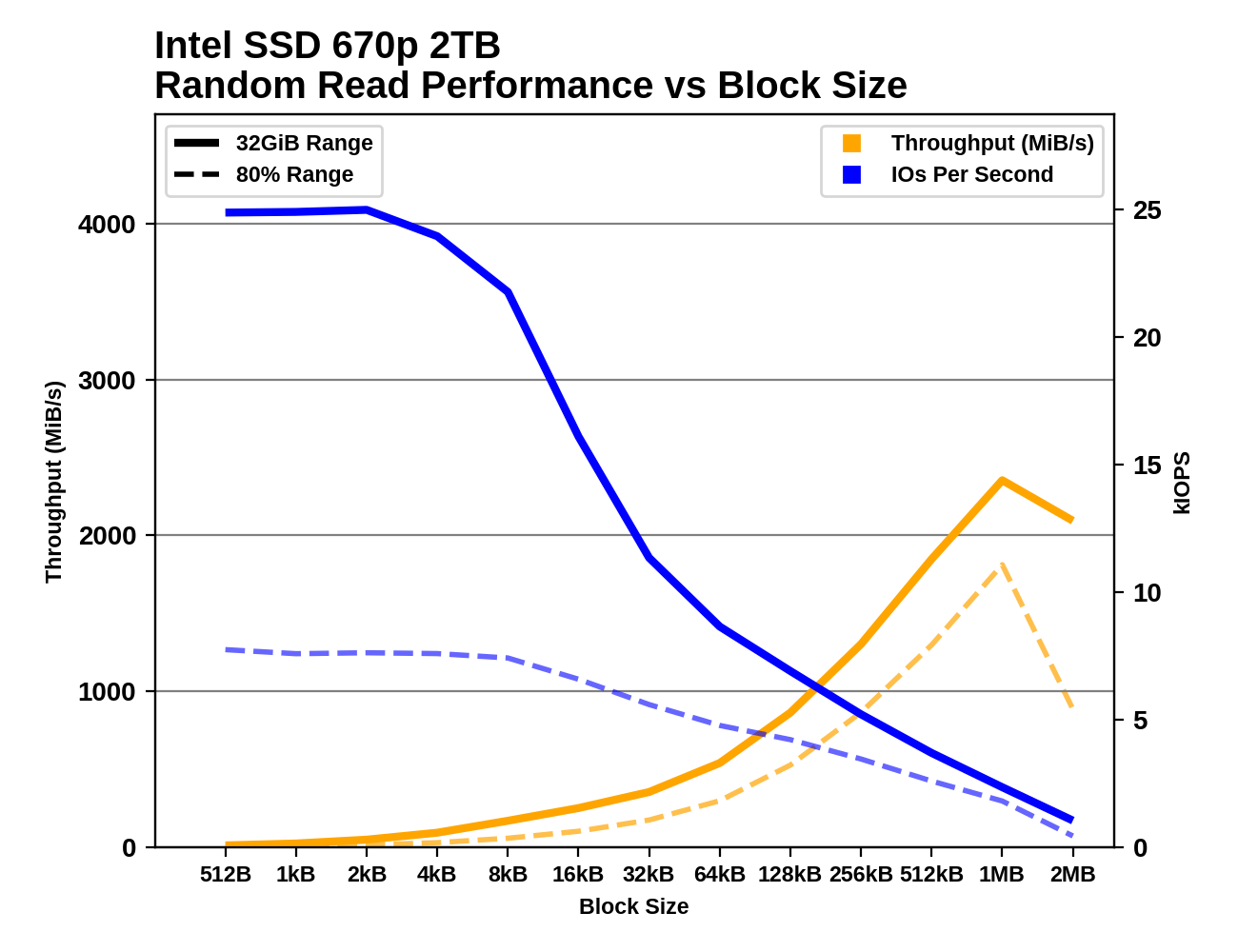The Intel SSD 670p (2TB) Review: Improving QLC, But Crazy Pricing?!?
by Billy Tallis on March 1, 2021 12:00 PM ESTAdvanced Synthetic Tests
Our benchmark suite includes a variety of tests that are less about replicating any real-world IO patterns, and more about exposing the inner workings of a drive with narrowly-focused tests. Many of these tests will show exaggerated differences between drives, and for the most part that should not be taken as a sign that one drive will be drastically faster for real-world usage. These tests are about satisfying curiosity, and are not good measures of overall drive performance. For more details, please see the overview of our 2021 Consumer SSD Benchmark Suite.
Whole-Drive Fill
 |
|||||||||
| Pass 1 | |||||||||
| Pass 2 | |||||||||
The Intel SSD 670p shows less consistent performance than the 660p during the sequential drive write. Writing to the SLC cache bounces between two performance levels, just above and just below 3 GB/s. The cache runs out more or less on schedule and performance drops down into SATA territory with sporadic outliers that are faster than normal. There's a bit of a stepped downward trend in performance as the drive approaches full. On the second pass that overwrites data on a full drive, the 670p is even more inconsistent with short bursts up to SLC write speed throughout the process.
 |
|||||||||
| Average Throughput for last 16 GB | Overall Average Throughput | ||||||||
The overall average write speed of the 670p is now almost enough to saturate a SATA interface. At the tail end of the filling process it does dip down to hard drive speeds, but any large sequential transfer of data onto the 670p will definitely complete more quickly than any one hard drive can handle. The controller upgrade helps some here (primarily with the SLC cache write speed), but for the most part the NAND itself is still the bottleneck, which means the smaller capacities of the 670p will not perform as well.
Working Set Size
 |
|||||||||
Intel is still clearly using a reduced DRAM design with the 670p rather than the full 1GB per 1TB ratio that mainstream SSDs use. The drop in performance at large working set sizes closely mirrors what we saw with the 660p, albeit with higher performance across the board thanks to the lower latency of the 144L NAND.
Performance vs Block Size
 |
|||||||||
| Random Read | |||||||||
| Random Write | |||||||||
| Sequential Read | |||||||||
| Sequential Write | |||||||||
With the 670p, Intel has eliminated the IOPS penalty that random reads smaller than 4kB suffer on the 660p, but that effect is still present for random writes. The IOPS difference between the short-range tests that hit the SLC cache and the 80% full drive tests is bigger for the 670p than the 660p; the newer drive has generally improved performance, but is in some ways even more reliant on the SLC cache.
Sequential throughput on the 670p keeps increasing with larger block sizes, long past the point where the 660p saturated its controller's limits. The performance trends for both sequential reads and writes are well-behaved with little disparity between the short-range tests and the 80% full drive tests, and no indication of the SLC cache running out during the sequential write tests.










72 Comments
View All Comments
abufrejoval - Tuesday, March 2, 2021 - link
I'd say a well used SATA SSD (unless the form factor is not negotiable).Booting is read-mostly and often not that I/O intensive after all.
And then I generally try to avoid doing it, preferring systems that enable low-power idle or that will sleep. Pressing the power button first and then getting the coffee works wonders, too.
Samus - Monday, March 1, 2021 - link
I see Intel still refuses to give up their margins - no matter how uncompetitive or inferior the product may be.Looks like a good drive but the pricing is around 50% too high.
Glock24 - Monday, March 1, 2021 - link
I've never, NEVER seen any QLC drive worth buying. The pricing is always really bad in relation to brand name TLC drives. Even if they were cheaper, it's not worth because of all the drawbacks.Byte - Tuesday, March 2, 2021 - link
where does SSDs have to go from here? OLC? Would that be even possible? Or do we have to wait for the next breakthrough.Zizy - Tuesday, March 2, 2021 - link
PLC - penta-level cell. Each cell keeps 5 values -> 32 voltage levels are required to read that (2^N). It is possible, but it will take a while.dragosmp - Tuesday, March 2, 2021 - link
The gain in flash performance is impressive and worth keeping in mind for when Intel will drop the price to something reasonable.I have used a 1TB P1 in my gaming rig for close to 2 years now and it's solid. Worth keeping in mind most SSDs nowadays come with RAM caching software which hides some of the el-cheapo's disadvantages. Not about to say the P1 is a speed demon, but it doesn't have to be if it has 4GB of RAM buffer. I'd like this drive for the write endurance and 5 years of warranty though, which is a deffinite plus; when it gets below 200$/2TB, preferably below 150 on offer.
Wereweeb - Tuesday, March 2, 2021 - link
First of all: remember that TLC, QLC, etc... are not atemporal constants. They're different ways to build NAND Flash storage. E.g.: Planar TLC is comparable to 3D QLC in a lot of ways.And QLC/PLC are not inevitable. They could tweak other properties of 3D NAND to enable progress. If they ever find a way to substantially shrink 3D NAND, they'd have to go back to TLC, because otherwise QLC would behave like what we imagine PLC to be.
Second: current 3D QLC is simply good enough for 95% of consumers. Look at these numbers. At the right price, there would be no reason not to buy this if you don't have some kind of professional application which requires consistently high performance storage.
Third: Yeah, please don't buy SSD's from Intel anymore. There's absolutely no benefit to QLC if it isn't substantially cheaper. A Dramless TLC is also good enough for 95% of consumers and it likely won't commit sudoku in a couple of years.
Wereweeb - Tuesday, March 2, 2021 - link
Sorry, I meant "different properties to tweak in building NAND storage"Spunjji - Thursday, March 4, 2021 - link
100% behind this comment. I've considered buying Intel's QLC SSDs when I've seen them on sale for substantially less than TLC alternatives, but at retail price, they're a joke.HVAC - Monday, March 8, 2021 - link
But my SSDs are tasked exclusively to solve sudoku! What am I supposed to do after a couple of years? Use my worn out NVMe sticks to spread margarine on my pretzels?It's distressing enough to make one want to commit sudoku!